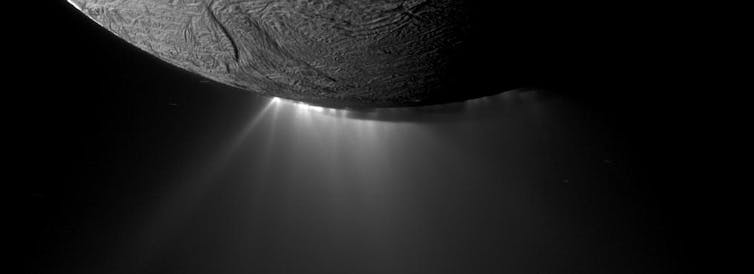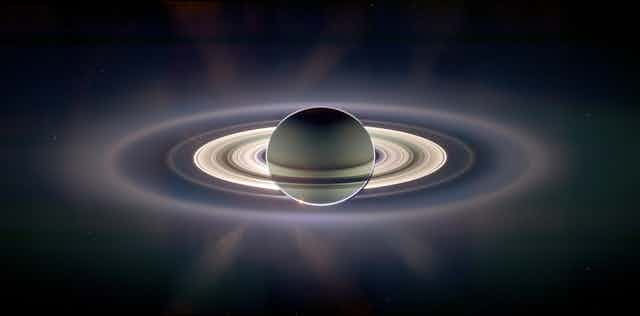It’s the slow beginning of what will be a violent end for the Cassini mission. At 10.00 BST on April 26, the spacecraft became the first ever to dive between Saturn and its spectacular innermost ring. This marks the start of its “grand finale” consisting of 22 daring orbits – enabling a new era of science. Then, on September 15, it will crash into the planet’s atmosphere and burn up. It is sure to be a sad but proud moment for those of us who have worked on the mission.
Cassini was initially set on its path to destruction on April 22 when it flew by Saturn’s moon Titan. The spacecraft has used Titan not just as a fascinating scientific target in itself, but also to provide the gravitational slingshots needed to tweak, crank and change its orbit. It is Titan that gave it the impetus to penetrate the 2,400km gap between the rings and the planet every week before the mission ends.

During the next few months, the instrument teams have several new observations to make in this region. These include understanding a new radiation belt discovered inside the rings early in the mission and taking close-up pictures of the rings and other features. It will also image Saturn’s cloud tops at close range, weigh its ring system (which will indicate just how old it is), sample the atmosphere of the planet and its rings, and measure Saturn’s internal structure.
Hazardous journey
But there are risks. The ring plane includes a lot of particles. These vary from micron-sized grains (a millimetre is equal to 1,000 microns) to mansion-sized chunks – and they could all collide with the spacecraft. Although Cassini’s path in the gap between Saturn and the rings has fewer particles than in the visible rings, we don’t know exactly how few.

However, it is thought that the risks of a significant dust hit in the ring plane are low. At the large relative speed – a maximum of 124,000km per hour – a hit could be a significant problem for the spacecraft. So, as Cassini flies through the ring plane, its high-gain antenna will be oriented to provide a shield for the rest of the spacecraft and its instruments. This was successfully done early in the mission when it was first inserted into orbit around Saturn, crossing outside the main rings.
The only protruding features beyond the shield are a 10-metre electric field antennae and an 11-metre magnetometer boom (used to make magnetic observations). These should make it possible to monitor dust impacts, each of which makes a tiny plume of plasma (loose and electrically charged particles) as the spacecraft and booms are impacted. Hopefully, no large impact will disable the spacecraft.
Indeed, the best computer models show that this should not happen. But even if it does, the spacecraft will eventually crash into Saturn – as it’s supposed to. That is important. Cassini must not crash onto interesting targets in the quest to find extraterrestrial lifeforms – particularly the moons Enceladus and Titan. These are subject to “planetary protection” which means we cannot put probes there which could carry contamination from Earth in the form of microbes.
The spacecraft will be useful until the very moment it burns up – it will be sending back data continuously. These last measurements of the composition of Saturn’s atmosphere, rotation rate and interior structure will be totally unique.
Personal highlights
I’ve been privileged to work on Cassini for 28 years. We proposed our instrument, the electron spectrometer, which measures the energy and direction of electrons, in 1989, and were selected to develop it in 1990. We then secured funding, and built, tested and calibrated the instrument before the launch in 1997.
The launch itself was a tense time. The powerful Titan IV rocket lifted off near dawn in October 1997, went behind a cloud from our vantage point and then thankfully emerged serenely on its way to Saturn, reaching the planet on July 1 2004. I remember nervously watching in the middle of the night as Cassini burned its engines for an excruciating 96 minutes to slow the spacecraft into Saturn orbit. Luckily it all went smoothly.
Cassini has operated at Saturn for almost half a Saturn year. It’s made many discoveries – in fact, it has rewritten the textbooks on the Saturn system. We now know that Saturn has 45 more moons than previously thought – placing the total now at 62.

At Titan, Cassini found prebiotic chemistry – which means the moon is essentially a frozen version of what the Earth was several billion years ago. Cassini also discovered that the moon has three large seas and a number of smaller lakes made of liquid methane.
At Enceladus, Cassini discovered water-rich plumes from a subsurface ocean and found that the ocean is salty. It recently also confirmed that chemical reactions between water and rock on the moon can provide enough energy in the water to feed microbial life. There have been many other incredible discoveries about the other icy moons, the atmosphere and the magnetosphere.

Some of the key discoveries we made with the electron spectrometer include large amounts of hydrocarbons and nitriles (a form of organic compound) in Titan’s atmosphere. These fall through the atmosphere and may form the dunes seen on Titan’s surface. We also uncovered Saturn’s ring atmosphere and ionosphere, and found weak atmospheres at the moons Rhea and Dione. An important discovery was that of water clusters and charged dust particles in plumes at Enceladus, helping us to understand that it has a subsurface ocean.
Needless to say, it has truly been an honour to be a part of the Cassini mission and a privilege to work with colleagues, postdocs and students through the years. As the mission heads towards its end, the overwhelming feeling is that this has been one of humankind’s most spectacular voyages of discovery.
But there are tantalising discoveries yet to be made. Enceladus has just recently joined Mars and Jupiter’s moon Europa in the top three likely locations for life beyond Earth in our solar system. I’m involved in the continued search for life on Mars with the ExoMars 2020 rover and at Jupiter’s icy moons with the JUICE mission. NASA also plans the Europa Clipper mission. Now, Cassini has shown us that we must go back to Titan and Enceladus, too.

